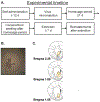Overexpression of ASIC1A in the nucleus accumbens of rats potentiates cocaine-seeking behavior
- PMID: 30397978
- PMCID: PMC9092352
- DOI: 10.1111/adb.12690
Overexpression of ASIC1A in the nucleus accumbens of rats potentiates cocaine-seeking behavior
Abstract
Acid-sensing ion channels (ASICs) are abundantly expressed in the nucleus accumbens core (NAcore), a region of the mesolimbocortical system that has an established role in regulating drug-seeking behavior. Previous work shows that a single dose of cocaine reduced the AMPA-to-NMDA ratio in Asic1a-/- mice, an effect observed after withdrawal in wild-type mice, whereas ASIC1A overexpression in the NAcore of rats decreases cocaine self-administration. However, whether ASIC1A overexpression in the NAcore alters measures of drug-seeking behavior after the self-administration period is unknown. To examine this issue, the ASIC1A subunit was overexpressed in male Sprague-Dawley rats by injecting them with adeno-associated virus, targeted at the NAcore, after completion of 2 weeks of cocaine or food self-administration. After 21 days of homecage abstinence, rats underwent a cue-/context-driven drug/food-seeking test, followed by extinction training and then drug/food-primed, cued, and cued + drug/food-primed reinstatement tests. The results indicate that ASIC1A overexpression in the NAcore enhanced cue-/context-driven cocaine seeking, cocaine-primed reinstatement, and cued + cocaine-primed reinstatement but had no effect on food-seeking behavior, indicating a selective effect for ASIC1A in the processes underlying extinction and cocaine-seeking behavior.
Keywords: abstinence; incubation; reinstatement; self-administration; withdrawal.
© 2018 Society for the Study of Addiction.
Figures



Similar articles
-
Prelimbic cortex and ventral tegmental area modulate synaptic plasticity differentially in nucleus accumbens during cocaine-reinstated drug seeking.Neuropsychopharmacology. 2014 Apr;39(5):1169-77. doi: 10.1038/npp.2013.318. Epub 2013 Nov 15. Neuropsychopharmacology. 2014. PMID: 24232172 Free PMC article.
-
Drug Refraining and Seeking Potentiate Synapses on Distinct Populations of Accumbens Medium Spiny Neurons.J Neurosci. 2018 Aug 8;38(32):7100-7107. doi: 10.1523/JNEUROSCI.0791-18.2018. Epub 2018 Jul 5. J Neurosci. 2018. PMID: 29976626 Free PMC article.
-
Accumbens brain-derived neurotrophic factor (BDNF) transmission inhibits cocaine seeking.Addict Biol. 2019 Sep;24(5):860-873. doi: 10.1111/adb.12638. Epub 2018 Jun 11. Addict Biol. 2019. PMID: 29890020 Free PMC article.
-
Attenuation of cocaine seeking in rats via enhancement of infralimbic cortical activity using stable step-function opsins.Psychopharmacology (Berl). 2019 Jan;236(1):479-490. doi: 10.1007/s00213-018-4964-y. Epub 2018 Jul 12. Psychopharmacology (Berl). 2019. PMID: 30003306 Free PMC article. Review.
-
Interactive role of acid sensing ion channels and glutamatergic system in opioid dependence.Neurosci Biobehav Rev. 2022 Apr;135:104581. doi: 10.1016/j.neubiorev.2022.104581. Epub 2022 Feb 15. Neurosci Biobehav Rev. 2022. PMID: 35181397 Review.
Cited by
-
Acid-Sensing Ion Channel 2: Function and Modulation.Membranes (Basel). 2022 Jan 19;12(2):113. doi: 10.3390/membranes12020113. Membranes (Basel). 2022. PMID: 35207035 Free PMC article. Review.
-
Mice lacking acid-sensing ion channel 2 in the medial prefrontal cortex exhibit social dominance.Sci Adv. 2024 Oct 25;10(43):eadn7573. doi: 10.1126/sciadv.adn7573. Epub 2024 Oct 25. Sci Adv. 2024. PMID: 39453995 Free PMC article.
-
Striatonigrostriatal Spirals in Addiction.Front Neural Circuits. 2021 Dec 10;15:803501. doi: 10.3389/fncir.2021.803501. eCollection 2021. Front Neural Circuits. 2021. PMID: 34955762 Free PMC article. Review.
-
Acid-Sensing Ion Channels: Focus on Physiological and Some Pathological Roles in the Brain.Curr Neuropharmacol. 2021;19(9):1570-1589. doi: 10.2174/1570159X19666210125151824. Curr Neuropharmacol. 2021. PMID: 33550975 Free PMC article. Review.
-
Triggering of Major Brain Disorders by Protons and ATP: The Role of ASICs and P2X Receptors.Neurosci Bull. 2023 May;39(5):845-862. doi: 10.1007/s12264-022-00986-8. Epub 2022 Nov 29. Neurosci Bull. 2023. PMID: 36445556 Free PMC article. Review.
References
-
- Backstrom P, Hyytia P (2007) Involvement of AMPA/kainate, NMDA, and mGlu5 receptors in the nucleus accumbens core in cue-induced reinstatement of cocaine seeking in rats. Psychopharmacology 192:571–580. - PubMed
-
- Caine SB, Heinrichs SC, Coffin VL, Koob GF (1995) Effects of the dopamine D-1 antagonist SCH 23390 microinjected into the accumbens, amygdala or striatum on cocaine self-administration in the rat. Brain Res 692:47–56. - PubMed
Publication types
MeSH terms
Substances
Grants and funding
- R01 DA034684/DA/NIDA NIH HHS/United States
- DA034684/National Institutes of Health/National Institute on Drug Abuse/International
- R01 MH113325/MH/NIMH NIH HHS/United States
- DA043364-01/National Institutes of Health/National Institute on Drug Abuse/International
- F31 DA043364/DA/NIDA NIH HHS/United States
LinkOut - more resources
Full Text Sources
Medical

